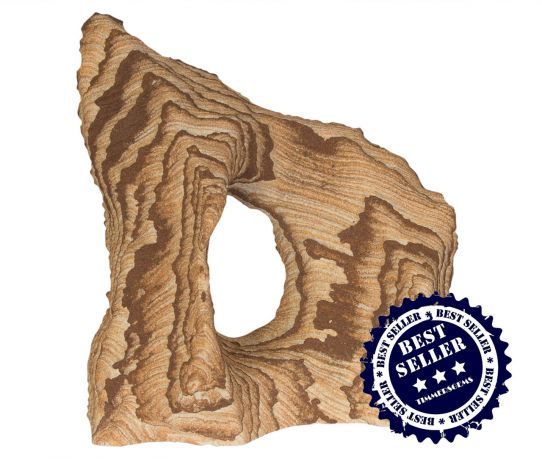We use cookies to make your experience better.
Sandstone Sculptures LARGE (180-220 mm) from Arches America
- Buy 5 for €38.00 each and save 16%
Sandstone is a sedimentair- or sedimentary rock consisting primarily of grains of sand. In sedimentation of sand grains are also silt, lime, gravel, glimmers, feldspar and other rock fragments deposited. Weathering is an originally yellow-brown sandstone gray. The occurrence of certain oxides and other minerals turns brown red variants. Sandstone consists mainly of quartz. Sandstone in the Netherlands and Belgium pretty much used as building material. In the Netherlands, especially the Bentheim sandstone (from Bentheim) and the Oberkirch Ener sandstone (from Obernkirchen) applied and sculptures also, by the large scale content, fine-grained Baumberger sandstone, which is very suitable for fine stone and sculpture, but not very weatherproof is. In the Netherlands, the name sandstone is used only for pure sandstone (without calcium) mainly from Northern Germany and in a period around 1900 also in Luxembourg and its environs were imported. The sandy limestone ledestone, balegemstone and Gobertange from Belgium (in Belgium often called limestone), which are found in particular with many medieval buildings are not usually counted among the sheer sandstone in the Netherlands. The common term for these stones is white Belgian stone. In the Netherlands, sandstone surface in eastern Twente at Winterswijk and in Limburg. However, it is not won here. In the rest of the Netherlands has not yet acted sufficiently diagenesis to get sandstone. Four centuries, from 1450 to 1850, was mainly from sandstone or via Bad Bentheim transported to the Netherlands on the Vecht. Cities like Ommen and Zwolle run here better for it. Due to the high cost of transport, the stone was mainly used in important buildings. The facades of the Royal Palace include built in Oberkirch Listener and Bentheim sandstone. The invention of the train came many exotic rock types on the market. This was the highlight of the trade in 'Bentheimerstraat Gold' past. In and around Bentheim still is now obtained at relatively small scale sandstone, especially in Gildehaus; the quarry near Oberkirchen is much larger operation.
Arches National Park is a relatively small national park near Moab in eastern Utah. There are several walks (trails) in the park. There is also a visitor center. Arches National Park is famous for its impressive rock formations and balancing rocks like the Courthouse Towers, Windows Section, Fiery Furnace, Devils Garden, Klondike Bluffs and Balanced Rock. There are over 2,000 documented natural bridges (arches), including the Landscape Arch, Double Arch, Double O Arch, and Delicate Arch. The smallest arcs have an opening of just one meter, while the distance between the supports of the main arc (the Landscape Arch) is 88.4 meters. In 1991, there is a piece of the Landscape Arch degraded with the dimensions of 20m at 3,66m at 1,33m. A witness made this a movie. Now it is no longer allowed to walk under or on the arc. In 2005, the Wall Arch collapsed. In the north of the park is an area that is called the Devil's Garden. Here is a 11 kilometer long trail along which to achieve some arcs. The arches are formed by a combination of wind and water erosion, ice, tectonic activity and an unstable surface of salt. On a nice day it is hard to imagine that such primal forces here have affected hundreds of millions of years. The history of the arches starts some 300 million years ago. At that time the whole area was under water several times. As the water evaporated or the climate became drier salt remained behind. This salt piled up, and in some places were even layer several hundred meters thick. The salt layer was later covered with remnants of tides and winds. This sand distorted slowly from rock sometimes more than a kilometer thick. Salt is unstable when it is under pressure. The salt bed was the pressure of the overlying layers of distorted and caused vertical cracks in the rock layer above. In these cracks arose during winter ice that went off causing the rock to crumble. The loose stones were carried off by the wind. During wetter periods rained in the region and eroded the tear because water flowed through it. Erosion is still ongoing and will eventually lead to all arches and rock formations disappear. The process was accelerated when, in the period from ten to five million years ago, the Colorado Plateau was pushed up. The water sleet the slits so deep that the underlying salt was reached. Then it was washed away arose two valleys in the area.
| Dimensions | 140-160mm |
|---|












